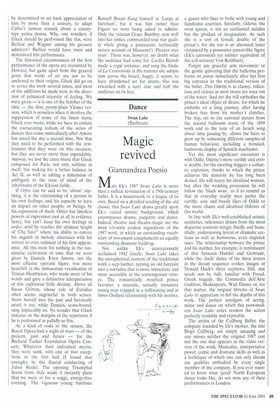Swan Lake (Barbican)
Magic revived
Giannandrea Poesio
Mats Ek's 1987 Swan Lake is more than a radical revisitation of a 19th-century ballet. It is a masterwork in a league of its own. Based on a detailed reading of the old classic, this Swan Lake draws greatly upon Ek's varied artistic background, which encompasses drama, puppetry and dance. Indeed, theatre and theatre-magic are the most vibrantly evident ingredients of the 1987 work, in which an outstanding vocabulary of movement complements an equally outstanding dramatic build-up.
Not unlike Ek's internationally acclaimed 1982 Giselle, Swan Lake takes the metaphorical content of the traditional work a step further, turning an old fairytale into a narrative that is more immediate and more accessible to the contemporary viewer. The romantically troubled prince becomes a neurotic, sexually immature young man trapped in a suffocating and at times Oedipal relationship with his mother, a queen who likes to frolic with young and handsome courtiers. Similarly, Odette, the swan queen, is not an enchanted maiden but the product of imagination. As such she is a sort of female double of the prince's, for she too is an alienated loner victimised by a possessive parent-like figure (Ek's cartoonish yet sinister equivalent of the evil sorcerer Von Rothbart).
Forget any graceful arm movement or the gentle quivering that the ballerina performs on pointe immediately after her first big entrance in the traditional version of the ballet. This Odette is as clumsy, ridiculous and vicious as most swans are once out of the water. And yet she still embodies the prince's ideal object of desire, for which he embarks on a long journey, after having broken free from his mother's clutches. The trip, set to the national dances from the second ballroom scene of the 1895 work and to the tune of an Israeli song about time passing by, allows the hero to grow up by witnessing different samples of human behaviour, including a frenzied, humorous display of Spanish machismo.
Yet the most significant encounter is with Odile, Odette's more earthly and erotic double, for the meeting triggers a cathartic explosion, thanks to which the prince achieves the maturity he has long been denied. He will marry his idealised woman, but after the wedding procession he will follow the 'black swan', as if to remind us that in everyday reality men prefer the earthly, sexy and bawdy likes of Odile to the more chaste and idealised Odettes of this world.
In line with Ek's well-established artistic aesthetics, references drawn from the most disparate contexts mingle fluidly and beautifully, underscoring lyrical or dramatic sections as well as humorous, even slapstick ones. The relationship between the prince and his mother, for example, is reminiscent of that between Hamlet and Gertrude, while the 'duck' dance of the three jesters in the dream sequence evokes images of Donald Duck's three nephews. Still, one needs not be fully familiar with Freud, Greek tragedy, the Commedia dell'Arte tradition, Shakespeare, Walt Disney or, for that matter, the original libretto of Swan Lake to appreciate in full the depths of this work. The perfect amalgam of acting, mime and dance on which this post-modern Swan Lake relies renders the action perfectly readable and enjoyable.
The artists of the Cullberg Ballet, the company founded by Ek's mother, the late Birgit Cullberg, are simply amazing and one misses neither the original 1987 cast nor the one that appears in the video version of the work. Musicality, interpretative power, comic and dramatic skills as well as a technique of which one can only dream are qualities embodied by every single member of the company. If you ever wanted to know what 'good' North European dance looks like, do not miss any of their performances in London.


































































 Previous page
Previous page